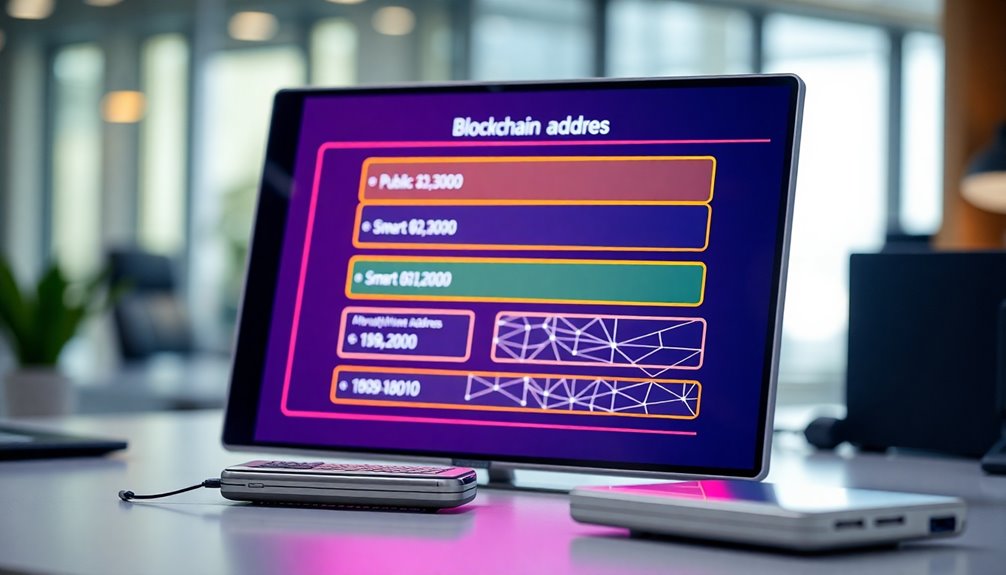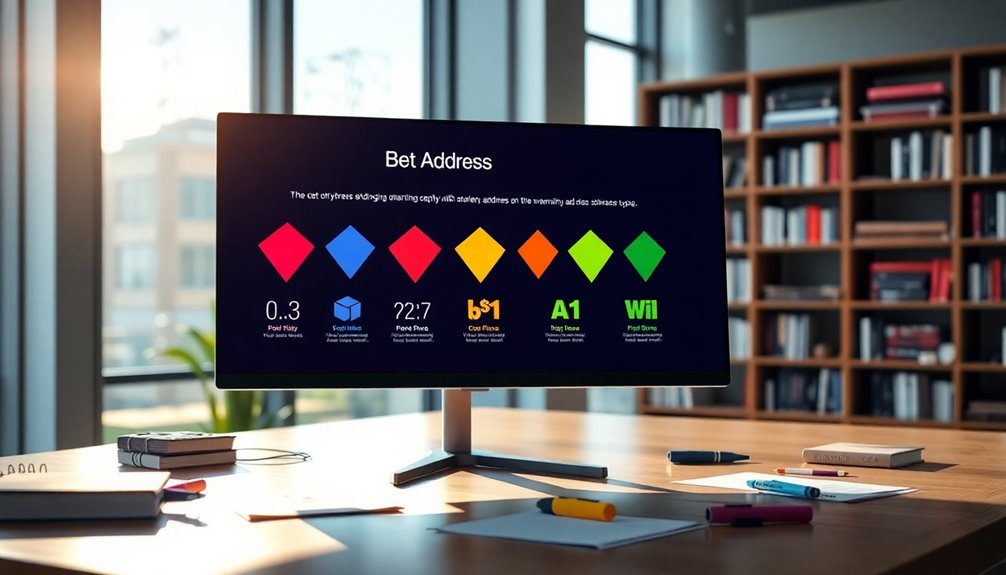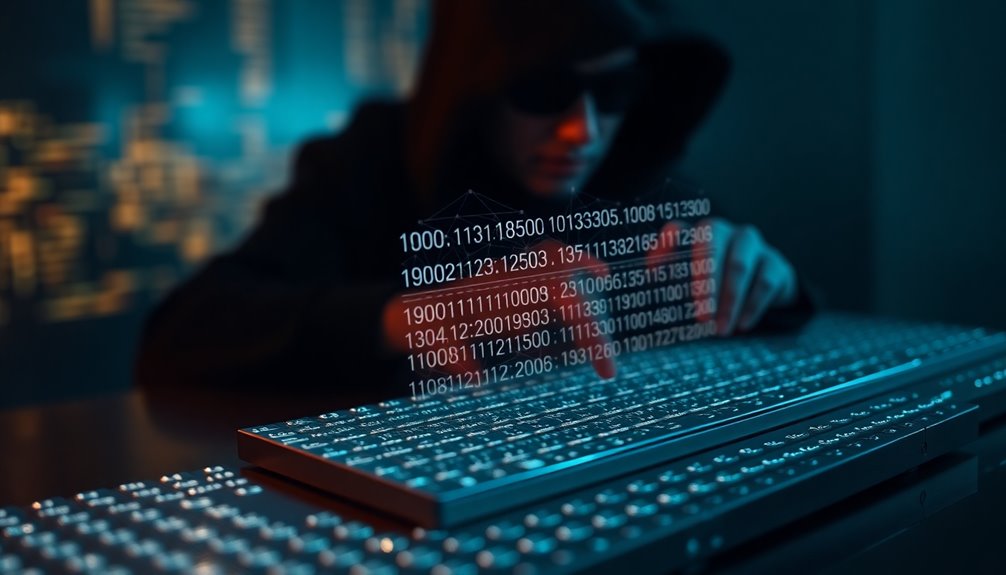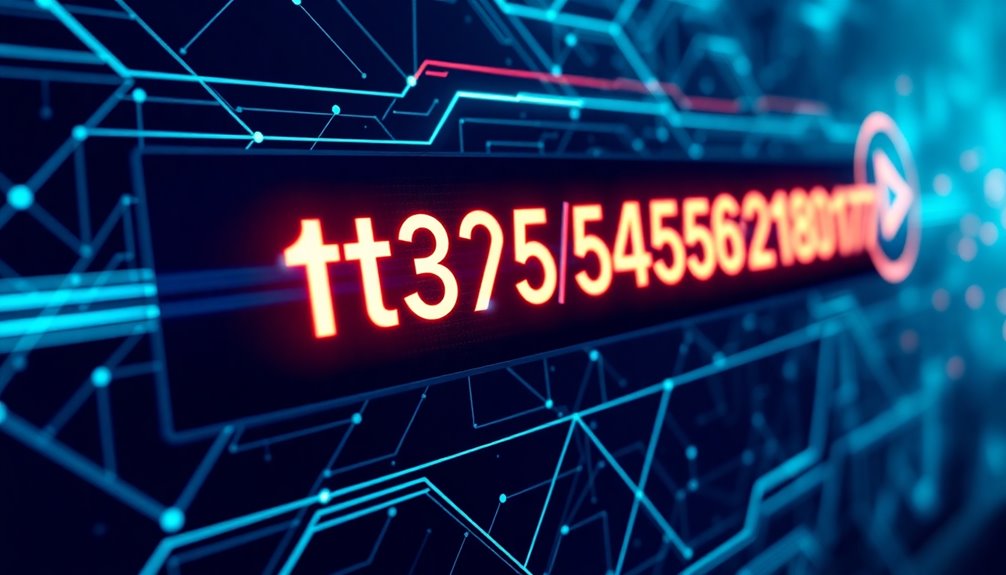When you explore blockchain addresses, you'll find that they act as unique identifiers for cryptocurrency transactions. Different address formats exist, like Bitcoin's Legacy and SegWit or Ethereum's "0x". Creating these addresses involves generating a private key, then deriving a public key to form the address. It's crucial to understand the differences between public addresses, which can be shared, and private keys, which must remain secure. With potential risks like phishing and lost private keys, knowing best practices for address management and security is vital. Stick around, and you'll discover even more insights into maximizing your blockchain experience.
Key Takeaways
- Blockchain addresses are unique identifiers for transactions, derived from public keys using cryptographic algorithms to ensure security and validity.
- Address formats vary across cryptocurrencies, including Legacy, SegWit, Ethereum, Ripple, and Litecoin, each serving different purposes and benefits.
- Public addresses can be shared for receiving payments, while private addresses must remain secure to prevent unauthorized access to funds.
- Creating a blockchain address involves generating a private key, deriving a public key, hashing it, and formatting it according to the blockchain type.
- Users should regularly monitor wallet activity, utilize recovery seeds for backup, and stay informed about security practices to protect their assets.
Address Types Overview

When navigating the world of blockchain, understanding the different address types is crucial. Bitcoin addresses fall into three main categories: Legacy, SegWit, and Ethereum. Legacy addresses start with a "1" and can be 26 to 34 characters long, using a mix of letters and numbers. SegWit addresses, which begin with "3" or "bc1q," are more efficient, resulting in lower fees and smaller transaction sizes. Ethereum addresses always start with "0x" and consist of 42 hexadecimal characters. Other blockchains have their own formats; for example, Ripple starts with "r," while Litecoin begins with "L." Knowing these formats helps you make informed decisions and optimize your transactions. Additionally, understanding the functionality of addresses is essential for effectively sending and receiving cryptocurrencies.
Understanding Blockchain Address Fundamentals

Understanding blockchain address fundamentals is essential for anyone looking to engage effectively with cryptocurrencies. These addresses serve as your destination for sending and receiving payments, helping you interact with smart contracts and view transaction histories. Each address verifies ownership of a wallet, adding a layer of security and preventing fraud. Moreover, addresses enhance transparency in transaction records, allowing users to track their crypto movements easily.
It's crucial to differentiate between public and private addresses; share your public address freely, but keep your private one secure.
Addresses are derived from public keys through hashing, ensuring they're unique and valid. Remember, formats vary across networks—like Bitcoin's '1' or '3' and Ethereum's '0x'—and each has its own compatibility requirements.
Understanding these basics will set you up for success in the crypto space.
Address Creation Process Explained

Creating a blockchain address involves a series of systematic steps that ensure each address is unique and secure.
First, a private key is generated using a random sequence of characters, serving as your secure identifier for the digital wallet. You must keep this private key secret, as it's crucial for signing transactions.
Next, the public key is derived from the private key through a mathematical algorithm. This process relies on the cryptographic techniques inherent to blockchain technology.
Then, the public key is hashed using algorithms like SHA-256 to generate the blockchain address. This address is usually formatted based on the blockchain type and can include a checksum for added validity.
Finally, you can share your address to receive payments, but be mindful of privacy concerns.
Pros and Cons Summary

While blockchain addresses offer significant advantages, such as enhanced security and user control, they also come with notable drawbacks. You benefit from strong security through cryptographic keys and enjoy anonymity in your transactions. However, once a transaction is verified, it can't be reversed, which could lead to permanent loss if you send assets to the wrong address. Additionally, managing blockchain addresses can be complex, requiring technical knowledge that may overwhelm some users. If you lose your private keys, you could lose access to your digital assets entirely. Lastly, while decentralized transactions save time and costs, scalability issues can impact processing speeds. Furthermore, the transaction transparency offered by blockchain addresses requires careful management to maintain privacy. Weighing these pros and cons is essential for informed decision-making in blockchain usage.
Address Type Effectiveness Analysis

When evaluating the effectiveness of different blockchain address types, it's important to consider their unique features and how they align with your needs.
Legacy addresses are widely supported but can lead to higher fees due to their larger transaction sizes.
Nested SegWit addresses offer a bridge between Legacy and SegWit, allowing for reduced fees while maintaining compatibility.
If you're focused on efficiency, Native SegWit (Bech32) addresses provide lower fees and better error detection, though they may lack support from older wallets. Additionally, complex transactions can benefit from the use of Script Hash Addresses, which allow for multi-signature capabilities and enhanced security.
For complex transactions, Taproot addresses enhance privacy and scalability, but they aren't universally accepted yet.
Ultimately, select the address type that best suits your transaction requirements and wallet compatibility for optimal results.
Security Vulnerabilities and Exploits

As blockchain technology evolves, so do the security vulnerabilities that threaten its integrity and users.
Phishing attacks are a major concern, targeting individuals to steal credentials or private keys through malicious links. Always verify the source of links and use reputable antimalware tools to detect these threats.
Consensus protocols also face risks, such as 51% attacks, which enable fraud if exploited. Maintaining a high hash rate can help mitigate this risk, as a higher hash rate reduces the likelihood of attackers gaining control.
Smart contracts aren't immune either; vulnerabilities can lead to significant exploits, so regular audits and using well-tested libraries are essential.
Lastly, network attacks like man-in-the-middle and Sybil attacks can disrupt transactions, making strong encryption and identity verification critical for securing your blockchain experience.
Decentralized Identity Integration

Decentralized identity integration revolutionizes how individuals manage their personal information, empowering you to take control of your digital identity.
With decentralized identifiers (DIDs), you gain unique identifiers that ensure data security and privacy. Verifiable credentials (VCs) issued by trusted organizations further enhance your credibility, as they can be verified using private keys.
The blockchain network acts as a tamper-proof ledger, ensuring your identity remains secure. Through identity wallets, you manage your DIDs and VCs, deciding when to share your information. This technology enhances user control by allowing individuals to dictate the extent of their data sharing.
This user sovereignty shifts control from centralized entities to you, aligning with Web3 principles. The integration also simplifies access management and regulatory compliance, making it easier for you to navigate the digital landscape confidently.
Use Strong Passphrases Consistently

Using strong passphrases consistently is essential for safeguarding your digital assets. A strong passphrase can create approximately 5.9 × 10^197 different wallets, enhancing your security significantly.
By using passphrases, you can generate multiple wallets from a single recovery seed, which is perfect for managing your holdings and creating decoy wallets to mislead potential thieves. Moreover, the order of words in your recovery seed is crucial; changing the order will result in a completely different seed.
Always choose passphrases that are four to six English words long for a balance of security and memorability. Remember to be consistent in your formatting—whether you use all uppercase, all lowercase, or include spaces.
Test your passphrase by sending a small amount of Bitcoin to ensure it's correct. This diligence will help you keep your assets safe in the evolving blockchain landscape.
Frequently Asked Questions
Can I Change My Blockchain Address Later?
Yes, you can change your blockchain address later.
You'll typically go to your wallet's interface, find the option to modify your address, and enter the new one. After confirming the change, it may take a few minutes for the update to reflect.
Remember, this process can vary depending on the wallet you use, so check for specific instructions related to your platform.
Always ensure you're following the correct steps to avoid issues.
How Do I Recover a Lost Blockchain Address?
Imagine your blockchain address as a treasure map, guiding you to your digital gold. If you've lost it, don't panic.
Start by checking your backup files or seed phrases; they're your lifeline. Use wallet recovery tools like BTCRecover or reach out to your wallet provider for assistance.
If all else fails, consider professional recovery services. Remember, safeguarding your recovery information is crucial to prevent future losses.
Your treasure awaits!
Are Blockchain Addresses Completely Anonymous?
Blockchain addresses aren't completely anonymous. They provide pseudonymity, meaning while your real identity isn't directly linked, transactions are traceable to your address.
If someone connects your address to personal info, they can track all your transactions. Techniques like using new addresses for each transaction or coin-mixing can enhance your privacy, but they're not foolproof.
Always be cautious about sharing any information that could link back to your blockchain activity.
Can Multiple Addresses Be Used for One Account?
Yes, you can use multiple addresses for one account.
Each address is generated from a unique private key linked to your recovery seed. This setup allows you to manage your transactions more effectively and enhances your privacy.
By using different addresses, you can keep your transactions separate, making it harder for others to link them together.
What Happens if I Send Funds to an Invalid Address?
If you send funds to an invalid address, don't worry—your money won't disappear!
The transaction simply won't broadcast on the network, meaning the funds will stay safe in your wallet. The network rejects the invalid address, so you won't incur any fees or gas costs.
You can easily resend the transaction to the correct address without losing anything. Always double-check addresses to avoid this hassle in the future!
Conclusion
In the grand tapestry of blockchain, you've glimpsed the myriad addresses that weave our digital identities. As you navigate this fascinating landscape, remember that each address holds promise and peril alike. Embrace the art of strong passphrases, and keep an eye on the horizon for emerging vulnerabilities. By understanding these nuances, you're not just securing your assets; you're crafting a safer digital future. So, step forward with confidence, and let your blockchain journey unfold.









